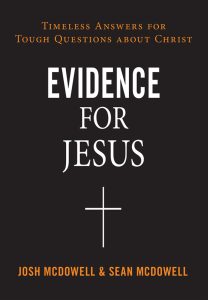Follow the historical facts!
By the time Josh McDowell got to college, he had a huge chip on his shoulder. Not only because of his childhood abuse, but because his life lacked meaning and purpose.
Like many of us, Josh pretended to have it all together. He acted like he was happy. But he was exhausted from faking it. He was exhausted from chasing peace.

When Josh noticed a group of students who seemed to be genuinely happy, he decided he wanted what they had — until they told him the difference in their lives was Jesus Christ.
“Jesus Christ?” snapped Josh. “Don’t give me that garbage. I don’t need religion!”
“We didn’t say religion,” one girl in the group shot back. “We said Jesus!”
Josh informed the group that Christianity was for dimwits, not intellectuals like himself. Josh trusted hard facts, not faith. So the students challenged Josh to prove that Jesus isn’t who He said He is. Josh thought they were joking, but then realized that by disproving Jesus’ resurrection, he could rub it in their faces!
But after spending several months in European libraries meticulously researching historical documents, Josh had to admit that the evidence overwhelmingly pointed to their faith being rooted in fact, not blind faith. And that was a problem, because Josh had been holding God at arm’s length for years. He wasn’t sure he could trust God, and he certainly wasn’t ready to accept Jesus as his “savior.”
But over the following weeks, Josh eventually realized that everything he was trying so hard to gain — meaning, purpose, peace — had led him straight to the God he felt had abandoned him as a kid. Only now Josh knew that because Jesus had died and resurrected, as the facts supported, then God hadn’t abandoned him. God deeply loved Josh, as Jesus’ sacrifice for him so clearly demonstrated!
Josh decided to give God the chance to direct his life, and remove his anger. Now, roughly seven decades later, Josh says that pivotal decision gave him his best life.
Questions to Ponder
- Do you, as Josh once did, think Christianity is a religion for “dimwits”?
- Like Josh, are you not wanting to admit you need God?
- If you’re holding God at a distance, why?
Some say Jesus was just an ordinary man. Or, at best, a good teacher.
If that’s all He is, how did Jesus fulfill every single Old Testament prophecy about the long-awaited Messiah?

The Old Testament, written over a period of a 1,000 years, contains more than 300 references to Jesus, recorded hundreds of years before His birth.
The authors of the book Science Speaks analyzed the probability of a single man being able to fulfill all these prophecies. By looking at just eight of the prophecies, they calculated that odds to be 1 in 10 to the 17th power!
Just some of the requirements Jesus met: He was born in the race of the Jews, in the lines of Shem, Isaac, and Jacob, in the tribe of Judah, in the family of Jesse, in the house of David.
God even told prophets where Jesus would be born: Bethlehem. And that Jesus would arrive during a period in which the Jewish Temple was still standing (it was destroyed in AD 70 and not rebuilt).
A prophecy dating from 1012 BC (800 years before the Romans were regularly using crucifixion for public execution) foretold that the Messiah’s hands and feet would be pierced and that He would be crucified. But on the third day He would rise.
Could Jesus have possibly “fit” His life to match each of these exacting prophecies? No way! But God could, and did. Jesus is part of God’s master plan to bring all who accept His invitation back into a personal relationship with Him.
It should blow our minds that the Creator of the universe loves us that much!
Questions to Ponder
- Does this knowledge change your view of Jesus?
- Does this help you to believe that Jesus is God?
- If not, why not? What “proof” do you need?
Yes, of course. Surprised?
Let’s look at the two most important ancient non-Christian sources for evidence of Jesus: Cornelius Tacitus and Flavius Josephus.

Tacitus was a Roman historian who lived around Ad 56 to 120. Many scholars consider him the greatest Roman historian. His records cover the time of the Roman emperors Augustus through Nero.
His writings provide additional historical validation of important events recorded in the Bible’s New Testament.
Josephus was a Jewish politician, soldier, and historian who lived around AD 37-100. He’s considered the most important Jewish historian of ancient times. In his writings, Josephus offers a clear non-Christian attestation of Jesus as a historical person.
There are other non-Christian sources, such as Suetonius, Celsus, and Thallus, but Tacitus and Josephus alone suffice to establish that Jesus was a real person crucified by the Romans.
Questions to Ponder
- Did you know non-biblical records of Jesus exist?
- Does this help you to believe that Jesus could have been telling the truth?
- If not, why not? What “proof” do you need?
Historical documents confirm that Jesus was a real, historical figure who was crucified by the Romans.
Only God knows why He chose this brutal form of death to symbolize His great love for us. Perhaps because it was so public, and so brutal. Let’s look at the details we know about Jesus’ death.

After the Roman governor, Pontius Pilate, condemned Jesus to crucifixion, Jesus was viciously whipped, per Roman custom. Eusebius, a third-century historian, offers up horrific details of this torture: “The sufferer’s veins were laid bare, and the very muscles, sinews, and bowels of the victim were open to exposure.”
Why the public whipping? Crucifixion was a slow, torturous process that could delay death for several days. The resulting blood loss from this flogging helped to quicken the person’s death.
Adhering to Jewish law, Jews limited the number of lashes they could render to the person being punished to forty. The Pharisees, with their obsessive legalism, would limit their lashes to 39, so that if they miscounted they would not be guilty of breaking the law. But the Roman floggers had no such limitations.
Their whips, made of three or more leather throngs of various lengths, were interwoven with bone, lead, and perhaps even hooks. With every lash they inflicted, the lead and bone shards ripped the person’s backside to shreds. Their blows struck with such force that even the victim’s internal organs were damaged.
The prophet Isaiah wrote of the Messiah: “They shall see the Servant of God beaten and bloodied, an object of horror; so disfigured many were astonished. His face and His whole appearance were marred more than any man’s, one would scarcely know it was a person…” (Isaiah 52:14).
After the flogging, the Roman soldiers continued their torture of Jesus. They spit on Him and ridiculed Him by shoving long, sharp thorns, woven into the shape of a crown, into His head. By this point, from His significant blood loss, injury, and shock, Jesus would have been in a state of severe dehydration and cardiorespiratory failure. In case you’ve not really thought about the excruciating pain Jesus suffered for YOU, reflect on it now.
Next, Jesus was required to carry part of His cross to Golgotha, the crucifixion site. As the Gospels tell us, Jesus, by now a bloody, quivery mass of open, already infected wounds, repeatedly faltered as He struggled to carry the heavy patibulum, the horizontal beam of His cross. This eventually forced the Roman soldiers to pull a man from the watching crowd to carry it for Jesus.
Reaching Golgotha, Jesus then experienced the agonizing pain of the long metal nails being driven through His wrists (considered part of the hand in the language of Jesus’ day), to hold Him to the cross. The soldiers then twisted Jesus’ legs into an unnatural and painful position and drove nails through His feet as well.
Then hoisted upright, Jesus continued His excruciating march toward death, instinctively attempting to fight off suffocation by pulling Himself up by His wounded hands and feet to gain each breath. The word “excruciating” literally means “out of the cross.”
Despite this laborious struggle, Jesus still used His breath to communicate. Looking down at the Roman soldiers, Jesus prayed, “Father, forgive them for they know not what they do.”
Scripture tells us that it took Jesus six hours to die, which surprised the Roman soldiers, because it typically took most victims several days to die. Pilate was so skeptical upon hearing of the speedy death, that he demanded certification of the death, by numerous soldiers, before allowing Joseph of Aramathea to take possession of Jesus’ body.
Skeptics have suggested that Jesus merely fainted. But this can’t be true. Documented history records that the Romans used crucifixion to kill their enemies, not merely publicly humiliate them. Pilate took great pains to confirm Jesus’ death.
Questions to Ponder
- Have you ever considered the amount of pain Jesus went through for you?
- How does the cross make you feel? What emotions come up for you?
- What questions do you have about why Jesus died for you?
Jewish law prevented a crucified person from hanging on the cross during the Sabbath, which is why Jesus’ body was so hastily prepared for burial after the Romans confirmed that Jesus was dead.
So what details do we know about Jesus’ burial?

Joseph of Arimathea, a member of the Jewish group that demanded Jesus’ death, boldly asked Pilate for Jesus’ body, and quickly transported Jesus’ body to the new, unused tomb he owned. Historical sources confirm that Joseph provoked both Roman and Jewish elders with his request, eventually spending time in prison. Nicodemus, another Jewish leader who secretly believed in Jesus, stepped up to help Joseph prepare Jesus’ body for burial.
Starting at Jesus’ feet, the two men would have wrapped Jesus’ body in linen cloth, placing aromatic spices mixed with a gummy substance called myrrh between the folds. Scholars estimate that at least a hundred pounds would have been used. As the gummy myrrh would have adhered so closely to Jesus’ body, it would have been difficult by this point for anyone to remove the linen cloth. And yet the Bible records that the burial cloths were found in the empty burial tomb — neatly folded!
Archaeologists have determined that rock tombs were used for burials during this time period. Each tomb had a groove, or trough, cut into the rock in front of it, which served to effectively seal the tomb closed as the heavy stone, which averaged a weight of two tons or more, was rolled into place at the entrance. Gravity, not just the stone’s weight, would have made it quite difficult to roll the stone back from the entrance.
Records tell us that Roman guards were posted at the tomb, to ensure Jesus’ disciples didn’t try to steal his body. After rolling the stone into place, the guards would have stretched a cord across the stone, fastening the ends with sealing clay. The clay was stamped with Pilate’s official signet, signifying the power and authority of the Roman Empire.
Roman guards were highly skilled soldiers, so they didn’t anticipate that Jesus’ body would go missing. And yet, three days later, Jesus resurrected just as He said He would. So it was to the chief priests that the soldiers ran for protection. They understood, only too well, that they would be severely punished, if not killed, by their superiors for failing to keep their prisoner under guard.
The Jewish leaders promised their protection, but also gifted the soldiers with a bribe for not telling anyone what they had witnessed before they fainted in terror: An angel as bright as lightning came down from heaven and rolled away the stone.
Yet, despite all the precautions and duplicity by both Rome and the Jewish leaders, nothing could prevent the Good News of this pivotal moment in human history from being shared with the world.
Questions to Ponder
- Two men from the group that demanded Jesus’ death buried Him. Interesting?
- Do these burial facts intrigue you to learn more about Jesus?
- If you’re holding Jesus at a distance, why?
Christian faith is rooted not in “blind faith,” but on historical fact that confirms that Jesus lived, was crucified by the Romans, and resurrected from death.
Let’s hone in on four facts that validate Jesus’ resurrection: the empty tomb, the left-behind grave clothes, post-resurrection appearances by Jesus, and the lack of opposing Jewish refutation.

The Empty Tomb
Jesus’ body was buried in the tomb of Joseph of Arimathea, a member of the Sanhedrin — the ruling body of Jews who ensured Jesus’ crucifixion.
The Gospels also tell us that, among His followers, it was a group of women that followed Jesus who first noted the empty tomb. They were surprised to see the stone rolled aside from the tomb’s entrance.
The testimony of the women help to validate the historical truthfulness of the empty tomb, because in this period of time women weren’t considered credible eyewitnesses.
Hearing the women’s eyewitness account, Peter and John, disciples of Jesus, found their courage and ran to see the empty tomb for themselves. Word began to spread of the miraculous disappearance.
The Discarded Grave Clothes
The Bible tells us that Peter and John spotted the abandoned burial clothes, neatly folded. This detail is important. If grave robbers had taken Jesus’ body, why delay their get-away by taking the time to laboriously remove the burial cloths? Body snatching isn’t a leisurely activity — it’s a quick, clandestine activity!
Numerous Appearances by Jesus
Jesus interacted with individuals and crowds of people in a physical, resurrected body that now possessed supernatural attributes. Jesus could, for example, now appear and disappear at will. The disciples touched Jesus’ wounds, spoke with Jesus, and even ate with Him.
An important reason: So that the disciples could never be persuaded that they had individually, or somehow collectively, hallucinated these events. Jesus was not just a spirit, but a real person. The term “resurrection” is not just a figure of speech. We are to take it literally.
Silence of the Jewish Authorities
The Jewish authorities assumed they had competently ridden themselves of their Jesus problem. But now, based on the eyewitness accounts of the terrified Roman soldiers, they realized they had failed. Jesus might actually be God — but they still were against Him. They wanted a Messiah who would wipe out the Romans.
From our modern perspective it appears they fumbled the ball in coming up with a good rebuttal that would have quickly put the resurrection rumors to rest. They spread the fictitious tale that the disciples took Jesus’ body — but they didn’t count on Jesus setting the record straight. It’s hard to get a lie to stick when the truth is walking around.
When Jesus returned to heaven, the Jewish authorities then tried to intimidate Jesus-followers into being quiet. But beatings, floggings, jail time, and death itself did not derail His committed disciples. Instead, their message of the “Good News” of Christ traveled far and wide. Millions of people owe their faith to these courageous individuals who chose self-sacrifice over safety. Knowing Jesus will do that to a person!
Questions to Ponder
- Will you only believe in Jesus if He miraculously appears to you?
- What questions do you have about the resurrection?
- Why do you think the Jewish authorities refused to accept Jesus?
When we’re asking, “Who is Jesus? Is He really the Son of God?,” we need to know if what the Bible says about Jesus is trustworthy.
Scholars have used three tests to confirm that the Gospels — the four books in the New Testament that record Jesus’s life, death, and resurrection — are based on factual evidence.

An example of how biblical manuscripts stack up against other historical documents: More than 20,000 copies of New Testament manuscripts exist. By comparison, there are only 643 manuscripts of the Iliad in existence.
The first, the Bibliographical Test, asks, “Are existing copies of biblical manuscripts faithful to the originals? What is the time interval between the original and copy? How consistent are the copies with one another?”
The second, the Internal Evidence Test asks, “Is the original text credible? To what extent is it credible?”
The third, the External Evidence Test, studies other historical materials to see where they confirm or deny this eyewitness testimony. The test asks, “What sources, apart from the Gospel writers, substantiate the Gospels’ accuracy, reliability, and authenticity?”
New Testament scholar Craig Bloomberg notes, that 97-99 percent of the New Testament can be reconstructed beyond any reasonable doubt. Apologist Douglas Groothuis adds that the New Testament is “better attested by ancient manuscripts than any other piece of ancient literature.”
Questions to Ponder
- Do you agree these tests confirm the Bible’s accuracy?
- Did you know that the Bible has been so deeply studied?
- Have you been thinking that the Bible is just moral stories?
Jesus’ followers viewed Him as sinless — but did Jesus share their view?
Jesus did not directly speak to His own perfection. Should this, as some critics assert, clue us in to the fact that Jesus didn’t see Himself as sinless? Not at all.

In a kind of sideways fashion, much of what Jesus said assumed or presupposed His own lack of sin.
In the New Testament, a variety of sources refer to Jesus as “the Holy One of God.” Both Mark and Luke record an incident in which “an unclean spirit,” that is, a demon, identified Jesus with the same title: “Now there was a man in their synagogue with an unclean spirit. And he cried out, saying, ‘Let us alone! What have we to do with You, Jesus of Nazareth? Did you come to destroy us? I know who You are — the Holy One of God!’”
Evidently, Jesus radiated a holiness, a purity, that the demons respected and feared.
The Jewish leaders intent on having Jesus killed tried to entrap Him using His own words and actions. The best they could come up with was that Jesus:
~ Broke the Sabbath by doing work on it
~ Was a friend to tax collectors and other sinners, and even ate with them
~ Claimed to be the King of the Jews
~ Taught the people to refuse to pay taxes to Caesar
~ Threatened to destroy the Jerusalem temple
~ Cast out demons because He was in league with the devil. (That makes no logical sense!)
~ Committed blasphemy by forgiving sins and claiming to be equal to God
Thomas Oden wrote one of the best expositions and defenses of the sinlessness of Jesus. In his writings he explains why Jesus’ lack of any apparent guilt over His own sin is quite revealing:
“Those who have walked the furthest on the way to holiness are those likely to be most keenly aware of their own guilt. St. Teresa of Avila, for example, understood most acutely how distant she was from the full possibility of life in Christ, but it was not because she was living distantly from the life but so near to it. … This was not morbid preoccupation with guilt but simply the expression of daily life lived so near to God that she was more painfully aware of each small increment of distance from God than others might have known in a lifetime. Yet Jesus, whose closeness to God could hardly be questioned, showed no evidences of such guilt or remorse or distance but rather sustained the closest filial relation.”
The Gospel of John reports moments when Jesus indirectly attests to His knowing Himself to be without sin. John 15:9: So Jesus said to them, ‘Truly, truly, I say to you, the Son can do nothing of His own accord, but only what He sees the Father doing. For whatever the Father does, that the Son does likewise.”
Questions to Ponder
- Does it feel important to you that Jesus never sinned?
- Sin is big deal to God. Why do you think that is?
- Would you agree with God that every person is a “sinner”?
The controversy about Jesus comes down to this core identity. Christians believe Jesus is the Son of God, the fulfillment of ancient biblical prophecies, the promised Savior of the world. Skeptics assert that Jesus was just a man, and possibly a great teacher — but just one among many who have walked the earth.
So which is it? Was Jesus just a man? Or was Jesus actually God, as He boldly claimed?

As Alister McGrath, Oxford professor of science and religion, writes: “The challenge posed to every succeeding generation by the New Testament witness to Jesus is not so much, ‘What did He teach?’ but ‘Who is He? And what is His relevance for us today?’”
When directly asked, “Are you the Christ, the Son of the Blessed?,” Jesus replied, “I Am.” Then the high priest tore his clothes and said, “What further need do we have of witnesses? You have heard the blasphemy!”
Jesus’ words were extraordinary in a Jewish culture that revered the teachings of prophets and patriarchs as sacred. On at least six occasions, Jesus uses this phrase of speech: “You have heard that it was said … but I say to you.” In doing so, Jesus was plainly contrasting His superiority to their Jewish tradition.
Theologian Michael Green writes that Jesus “asserted that He had a relationship with God which no one had ever claimed before. It comes out in the Aramaic word Abba (father) which He was so fond of using, especially in prayer.” Adds Green, “It is the familiar word of closest intimacy. That is why He differentiated between His own relationship with God as Father and that of other people.”
Jesus went even further: He received worship as God. Within the Jewish context in which the first Christians operated, it was God and God alone who was to be worshiped. So imagine the hurdle it took for the Jews hearing Jesus’ claims to call Him “Lord.” And yet, many did, as have millions over the years since.
Questions to Ponder
- Do you find it hard to believe that God took human form as Jesus?
- If Jesus is God, what does this mean for you?
- What parts of Christianity are difficult for you to accept?





